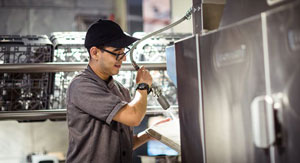If you’re working in foodservice, you’re also in the dishwashing business. Dishes, silverware, glassware and everything else essential for food prep must be sparkling clean and sanitized. So, once you’re in the market for a new dishwashing system, it’s important to know about different types of machines available.
 A more efficient dishwasher can mean not just cleaner dishes but increased employee satisfaction as well.
A more efficient dishwasher can mean not just cleaner dishes but increased employee satisfaction as well.
Number of meals served per hour, space considerations and your budget will help determine the type of machine that will work best for your kitchen. In addition, you should research whether a low-temperature or a high-temperature commercial dishwasher is the best choice.
A high-temperature washer uses very high heat (150°-180° degrees F.) to both wash and rinse the dishes. They are ideal for operations with more challenging food soils like egg and cheese, and are better at removing lipstick from glassware. Equipment add-ons like a booster heater and a vent hood are usually required. A low-temp washer still heats the water, but not to the degree of a high-temp model. The low-temp machine relies on chemicals to achieve proper sanitation, and additional equipment like a vent hood normally is not needed (however, check your local municipal code to be sure).
Advances in commercial dishwashing technology over the years have benefited customers, helping them realize water and energy savings. Ventless energy recovery models (a premium feature for high-temp units) use steam from within the washing chamber to raise the temperature of the incoming cold water, so the machine doesn’t have to work as hard to reach its required 180 degrees for sanitization. The result? Less energy is needed to operate the machine, and employees experience better working conditions due to the steam elimination. And, because the steam condenses and is removed from the chamber, a vent hood is not required—a $3,000-$5,000 savings alone.
Consider All the Costs
High-temp commercial dishwashers usually cost more up front and can slightly impact utility bills due to the energy needed to heat the water. Low-temperature models may come with a lower price tag, but the chemicals needed for the sanitation process must be purchased continuously. Low-temp machines also use more water than the high-temp versions, which can factor into the overall investment. Considerable pre-scrapping is required with low-temp models if you want to avoid the potential for rewashing.
Keep in mind that because the high-temp dishwashers need a vent hood to deal with steam, the location of the machine must be carefully planned. Even though the high-temp machine’s steam rises up through the hood, it’s a good idea to make sure the dishwasher is placed far away from the customer area.
Think About the Hidden Benefits
Both low-temp and high-temp dishwashers have different advantages. High-temp machines produce dishes that dry very quickly after they exit the washer, which means items can be put back into service faster. This is especially helpful during busy times. Low-temp washers are typically available in standard electrical service (120/60/1), an advantage for operations where electrical service isn’t adequate to power a high-temp machine. Just remember that you will achieve a better, more consistent wash with a high-temp unit. Low temperature, chemical sanitizing machines are best suited for applications where lighter soils are dominant.
Learning as much as possible about the pros and cons of high- and low-temp commercial dishwashers will help you make a smart purchase. Research brands to find the most reputable names and outfit your kitchen with a commercial dishwasher that provides the most benefits based on your guest volume, menu, available space, budget and the desired results.
Hobart offers complete lines of low-temperature and high-temperature commercial dishwashers, and you can learn more about their benefits and features by visiting https://www.hobartcorp.com/products/commercial-dishwashers.



